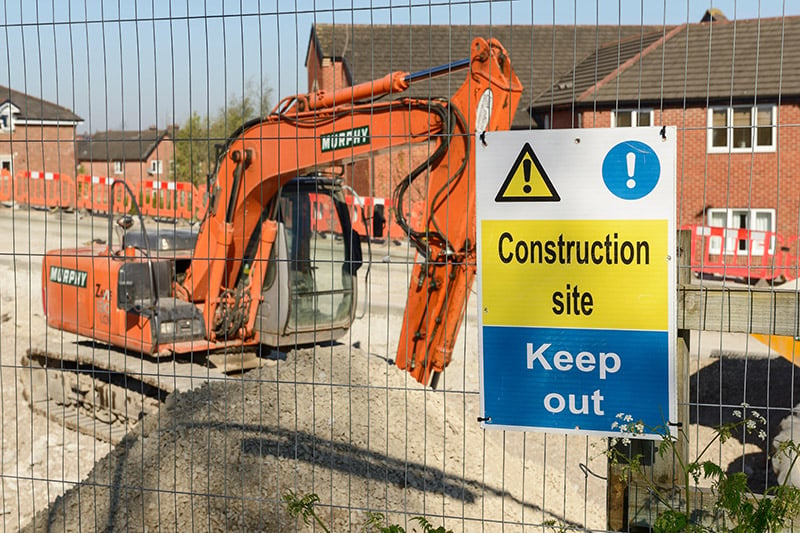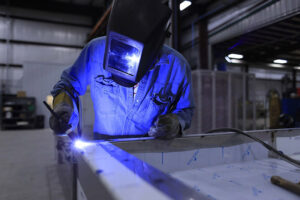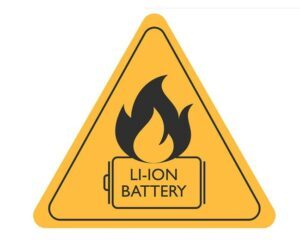While UK construction output witnessed a decline in the year of and following the Covid pandemic, construction fires in the latest ONS figures show an increase in incidents compared to previous years. Despite calls for greater professional competency and better technology available, fire hazards are only increasing with the likes of new construction materials, hot works and the presence of lithium-ion batteries. Hunter Seymour addresses the issue.
This year, two key announcements on construction site fire hazards have been published that point to heightened concerns for safeguarding best practice in fire prevention when protecting buildings under construction or undergoing refurbishment.
The latest UK Home Office figures, reported in May, reveal that “Primary Fires on Construction Sites” in England show an increase in incidents compared with the last recorded year surveyed in the previous 2019 report. This is despite a devastating 40% decline in UK construction output early in the first year of the Covid pandemic (2020).
Notably, months before Covid struck, the Fire Industry Association (FIA) had commented on the earlier report with the hope that in 2020 fires on construction sites would decrease due to “an increasing amount of people taking training to become more competent, coupled with technology and our use of it getting better.”

Credit: Alamy Stock
Mindful of this clear-sighted call to action, risk management should also be aware that at the start of this year, January 2023, the Fire Protection Association (FPA) in association with RISCAuthority, published their 10th edition of “Fire Prevention on Construction Sites”, incorporating significant amendments for a revised Code of Practice. These revisions reflect the changes in standards, practice, and use of modern materials in construction and renovation.
It is timely, then, to take a closer look at the implications for risk professionals of this new perspective on fire safety.
The objectives of the Code are well-defined: “The majority of fires can be prevented by designing out risks, taking simple precautions, and by adopting safe working practices. All parties involved must work together to ensure that adequate detection and prevention measures are incorporated during design and contract planning stages; and that the work on site is undertaken to the highest standard of fire safety, thereby affording the maximum level of protection to the building and its occupants.”
New materials under scrutiny
A particular emphasis in the amended Code is placed on the potential fire hazards of new materials when introduced into construction specifications or renovations. Detailed consideration at the design stage is therefore critical.
Criteria applied include the use of non-combustible and non-flammable materials to reduce the fire load; and reduction of the risk presented by all combustible insulating materials, in particular those in cladding systems, green roofing/walling (or similar alternative features) and structurally insulated panels.
In addition, attention should be given to temporary materials brought on to site such as non-combustible scaffold boards in place of timber boards in high fire risk areas.
Case study scenario: materials misapplied
A fire incident reported recently by CROSS-UK (Collaborative Reporting for Safer Structures UK) highlights the need for caution by designers to ensure materials specified for construction have the appropriate level of fire resistance.
An external walkway formed of a composite material contributed to external fire development in a block of flats, preventing access by firefighters and denying means of escape for occupants.
Such access to flats is often referred to as a common access balcony, common balcony, or a balcony/deck approach and the report makes clear that, in cases where this definition applies, it is imperative that “the structure, including the floor, should be protected by 30 minutes fire-resisting construction (integrity and insulation).”
Hot working: continuous vigilance
Zurich Insurance has calculated that over the course of a decade, hot work fires resulted in total losses of up to £70 million in the UK.
Hot works on construction sites refer to any activities that involve the use of open flames, sparks, or heat-producing tools and equipment. Examples include welding, cutting, brazing and soldering, where specific fire safety protocols would be required.
Data published last year revealed that fires caused by hot work accounted for 16% of all fires in buildings under construction in the surveyed year (Sep 2020 – Sep 2021).
A significant amendment in the new Code of Practice for construction sites extends and supplements the fire watch requirements when hot work is undertaken. It advises that any area specified in a hot work permit must be subject to a continuous fire watch, maintained during the period of works by a dedicated individual or individuals where a suitable and sufficient risk assessment indicates the potential for the impacts of hot work to be more widespread.
For example, sparks can quickly spread to neighbouring structures and cause fires that are hard to bring under control.
 Such circumstances include:
Such circumstances include:
- hot work undertaken close to timber framed structures
- high rise construction sites; where the presence of holes or voids may allow unseen smoldering
- where wall or floor openings within a 10-metre radius expose combustible materials in adjacent areas (which may include concealed spaces in wall or floor construction)
- locations where there is restricted access or visibility.
The continuous fire watch should be maintained for at least one hour after work is completed. Additional checks must be made at regular intervals for a further one hour but may be needed for longer, based on a risk assessment. In some cases, checking for up to three hours, or more, might be appropriate after cessation of hot work before the permit is signed off.
Thermographic cameras are recommended for use routinely for assessments and record-keeping, both pre- and post-work, to aid continuous monitoring of the area for any potential hot spots.
Note: Risk management should be aware that, where compliance with the Code forms part of an insurance contract, non-compliance could possibly result in insurance being revoked or ceasing to be available, resulting in a possible breach of a construction contract. Beyond the foremost considerations of critically risking the health and safety of all persons on the site – and apart from such breaches of contract – non-compliance could mean possible prosecutions in the event of a fire.
Case study scenario: non-indemnified losses
A major fire during roofing work occurred at a school in the pupils’ summer holidays. Plastic tarpaulins caught alight as a gas torch was being used, and the fire spread rapidly, destroying much of the school. Subsequent investigations identified a number of failings that meant the risk of a fire occurring had not been adequately addressed.
The critical issue in this incident was the absence of a hot work permit in place to ensure the works were being managed safely. In addition to that, materials were being stored on the roof where the hot work was taking place and there was no fire extinguisher on site.
The absence of a fire extinguisher may have put the contractor in breach of their Hot Works Warranty, as their insurer refused to indemnify them following the loss.
Wake-up call: risk implications of new technologies
In this brief round-up of the new amendments to this “Joint Code of Practice on the Protection from Fire of Construction Sites and Buildings Undergoing Renovation”, it should be pointed out that revisions due to technological advances apply to a number of key sections;
- Classifications of Standards
- Large timber frame structures
- Training of Responsible Persons and Fire Marshals
- Zone disablement procedures
- Use of extinguishers
- Removal of waste materials
- High rise construction sites
All of which (and others) should be carefully read for updated recommendations.
Electric vehicles and lithium-ion batteries
Apart from the wider scope of these revisions, a new section has been added to the Code of Practice warning of the dangers of electric vehicles – including cars, vans, bikes and scooters – with a view to address the controls required in relation to charging such vehicles and their prohibition on construction sites.
More pertinently, risk management may need to factor in the increasing presence of e-dumper trucks and e-forklift trucks in operation on construction projects in any review of safe working practices.
 Section 20, therefore, is a significant addition to tackle the hazards identified as fire risks perceived to be associated with this technology.
Section 20, therefore, is a significant addition to tackle the hazards identified as fire risks perceived to be associated with this technology.
Report warns: battery fires the next ‘legacy’ fire issue?
A recent CROSS Report highlights fire safety risks associated with Lithium-ion (Li-ion) batteries. An exponential rise in the use of Li-ion batteries (and other alternative energy sources with their own respective risks) is being driven by the agenda for achieving “net-zero” by reduction of emissions.
This drive has led to the use of Li-ion in all environments and scales, from small portable devices to scooters and electric vehicles (EVs).
Suppressing Li-ion battery fires remains a significant problem. It is often impractical or impossible for the fire brigade to extinguish such fires so dealing with them can often simply involve waiting for them to burn out or immersing them in water for a day or more.
How these alternative fuels and systems interact with the built environment should be of paramount concern to developers of such technologies.
The Report warns: “Insurers and government are key stakeholders in this, because if these concerns are left unaddressed then it is highly probable for battery fires to become the next ‘legacy’ fire issue, with a high cost to society and expensive remediation in the years to come.”
A recent highly disturbing video underscores just how intense the fire from a Li-ion battery can be. A fire that started from an e-Bike in The Ilac shopping centre, Dublin, very quickly erupted (5 seconds) with a ferocity that presented a life-threatening danger to passers-by.
This article was first published by SHP’s sister site for news on security and fire, IFSEC Insider.
Fire Safety in 2023 eBook
SHP's sister site, IFSEC Insider has released its annual Fire Safety Report for 2023, keeping you up to date with the biggest news and prosecution stories from around the industry.
Chapters include important updates such as the Fire Safety (England) Regulations 2022 and an overview of the new British Standard for the digital management of fire safety information.
Plus, explore the growing risks of lithium-ion battery fires and hear from experts in disability evacuation and social housing.


 Such circumstances include:
Such circumstances include: Section 20, therefore, is a significant addition to tackle the hazards identified as fire risks perceived to be associated with this technology.
Section 20, therefore, is a significant addition to tackle the hazards identified as fire risks perceived to be associated with this technology.